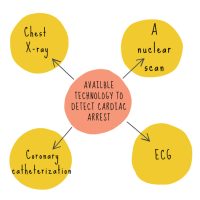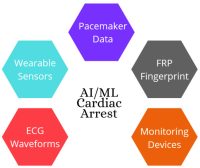Each year, nearly 356,000 cardiac arrests occur outside of a U.S. hospital. Cardiac arrest occurs when a person’s cardiac function is suddenly lost, whether they have been diagnosed with heart illness or it might appear out of nowhere, or due to other symptoms. If the right measures aren’t performed immediately, cardiac arrest can be deadly.

Cardiac arrest occurs due to cardiomyopathy, a condition in which the heart muscle becomes dilated or thickens, leading to abnormal contractions of the heart. Another form of cardiac arrest can happen when plaque blockages constrict and thicken the coronary arteries, restricting blood flow to the heart. If untreated, this might result in heart failure (HF) or arrhythmias, both of which can result in cardiac arrest. Signs of sudden cardiac arrest may vary from chest discomfort to sudden collapse.
Traditional Technologies
The available technology for the prevention of cardiac arrest includes an electrocardiogram (ECG), which detects the heart’s electrical activity using sensors (electrodes) placed on the patient’s chest and occasionally, limbs. An ECG can indicate cardiac rhythm problems or aberrant electrical patterns such as a prolonged QT interval that elevate the risk of sudden death,. Some blood and imaging tests are also conducted to check the level of chemicals in the body; for example, potassium, magnesium, hormones, and other substances that might alter the heart’s capacity to function may be measured in a blood sample. Other blood tests can reveal cardiac damage and heart attacks that have occurred recently.
A physician uses a chest X-ray to examine the size and form of the heart and blood vessels. Utilizing coronary catheterization, a technique in which a liquid dye is injected into the heart’s arteries employing a long, thin tube (catheter) that is pushed via an artery, generally in the arm, to the heart’s arteries. The arteries become apparent on X-ray and videotape as the dye fills them, exposing regions of obstruction. In addition, a nuclear scan, which is frequently combined with a stress test, aids in the detection of blood flow issues in the heart.
A piece of computerized medical equipment is called an automated external defibrillator (AED). It uses adhesive defibrillator pads that are put to the chest to let an electrical current flow through to the heart, resetting the heart’s natural electrical activity. The heart muscle to contract and circulate blood to the body requires a normal, regular, or ordered electrical rhythm. The most effective strategy to enhance sudden cardiac death (SCA) survival rates is to have an automated external defibrillator in every house and public location. AEDs are small, portable devices that give an electric shock to the heart, and they have been shown to save many lives when utilized promptly.
Market Need and Artificial Intelligence (AI)
The rising frequency of different coronary heart disorders such as cardiomyopathy, which is leading to cardiac arrest fatalities, attractive reimbursement schemes, and an increase in the geriatric population, are the primary drivers driving the market’s growth. According to the American Heart Association, nearly half of adults in the United States have a cardiovascular condition, resulting in increased demand for highly efficient, immediate treatment and more technologically advanced cardiovascular devices.
The processing of data is a critical stage in the development of prognostic models. Nonlinear prediction models, a high number of patients, and various predictors with intricate connections are all obstacles in data processing. These difficulties are tough to overcome in typical hypothesis-driven statistical analysis. Many patients who would benefit from preventative care are missed by current methods for predicting cardiovascular risk, while others receive unnecessary treatment. As a result, applying AI technologies such as machine learning (ML) and deep learning techniques to tackle the issues is becoming increasingly necessary.
 AI and ML approaches can increase cardiovascular risk prediction accuracy and reduce unnecessary use of medicine. By updating existing diagnostic and therapeutic support systems, machine learning approaches may improve heart failure outcomes and management while saving money. ML techniques can improve accuracy by utilizing complicated linkages between risk factors and be used to predict sudden cardiac death.
AI and ML approaches can increase cardiovascular risk prediction accuracy and reduce unnecessary use of medicine. By updating existing diagnostic and therapeutic support systems, machine learning approaches may improve heart failure outcomes and management while saving money. ML techniques can improve accuracy by utilizing complicated linkages between risk factors and be used to predict sudden cardiac death.
A variety of AI algorithms have been created to forecast the risk of abnormal cardiac diseases such as heart failure (HF) and atrial fibrillation. Machine learning algorithms have also been used to diagnose and forecast the likelihood of readmission and death following HF using just risk variables. While some recent study suggests utilizing AI to predict heart failure using both a collection of risk variables and 12-lead ECG data, there is seldom a comparison time frame, and if there is, it is for a relatively limited period, such as present to five years. Recent research has used ECG waveform data to train AI networks to detect cardiac problems, including ejection fraction, left ventricular systolic dysfunction, and mitral regurgitations.
The ubiquitous use of smartphones and smart speakers give a once-in-a-lifetime opportunity to discover the audio biomarker and connect cardiac arrest victims to emergency medical services or anyone who can administer cardiopulmonary resuscitation (CPR).
Another well-known device for cardiac patients is a pacemaker. It is placed surgically into the abdominal or chest cavities, and is intended for patients who have an arrhythmia or an erratic heartbeat, which indicates that the heart is beating too quickly, too slowly, or unevenly. The data generated by a pacemaker is significant and could be used in many ways to learn and predict behavior.
One great invention includes a fat radiomic profile (FRP) fingerprint that captures the amount of risk created using machine learning. In the SCOT-HEART experiment, the performance of this perivascular fingerprint was examined in 1,575 participants, revealing that the FRP had an incredible value in predicting heart attacks—much above anything now available in clinical practice. Professor Charalambos Antoniades of the University of Oxford’s Department of Cardiovascular Medicine and BHF Senior Clinical Fellow said, “We’ve developed a fingerprint to discover ‘poor’ traits surrounding people’s arteries by leveraging the power of AI.” This has enormous promise for detecting early indicators of illness and taking the necessary precautions before a heart attack occurs, perhaps saving lives.
Conclusion
The use of machine learning has its own critics as it is considered to be one of the most expensive techniques used for cardiac-related issues. Moreover, it requires a large amount of data for accurate results. Biases in the training data, model overfitting, insufficient statistical correction for several testing, and limited transparency around the procedures by which DL algorithms reach their output (“black box” systems) are just a few of the AI pitfalls that can have severe consequences for patients and necessitate careful consideration by researchers, clinicians and regulatory bodies.
Physicians have a significant opportunity and responsibility to actively watch the continual development of AI approaches and use and apply them according to their needs to discover essential supporting tools for their clinical practices. AI’s arrival in the cardiovascular profession brings a plethora of new opportunities for providing innovative, tailored treatment. The way we practice cardiology, particularly in cardiac imaging, is changing, and physicians must be prepared. mHealth and telemedicine are forming new links between patients and doctors, transforming healthcare from a passive to a ubiquitous activity. Physicians should not be terrified of AI’s incorporation into cardiology; instead, they should welcome it, because their specialist knowledge is always necessary.







